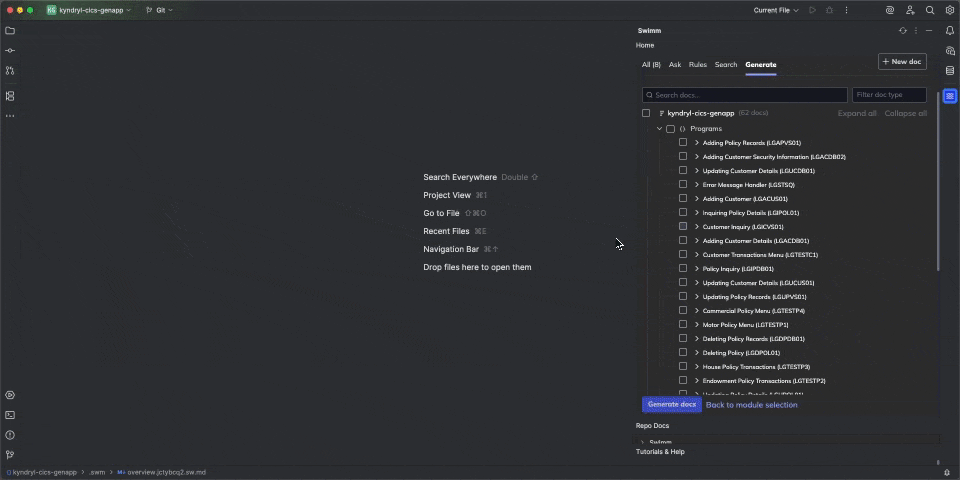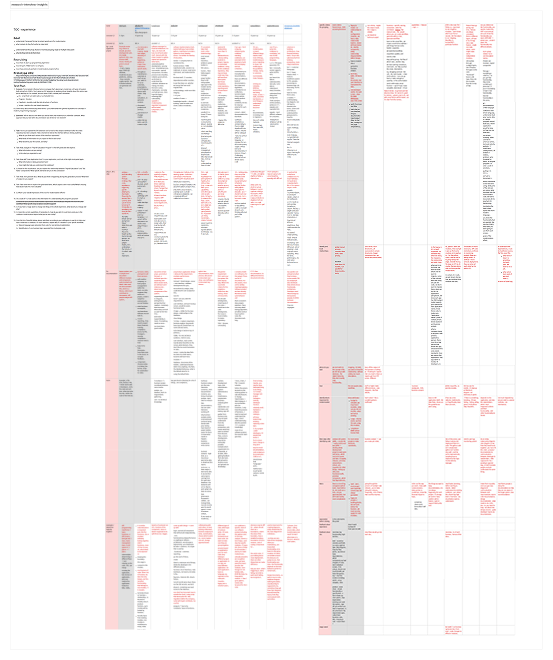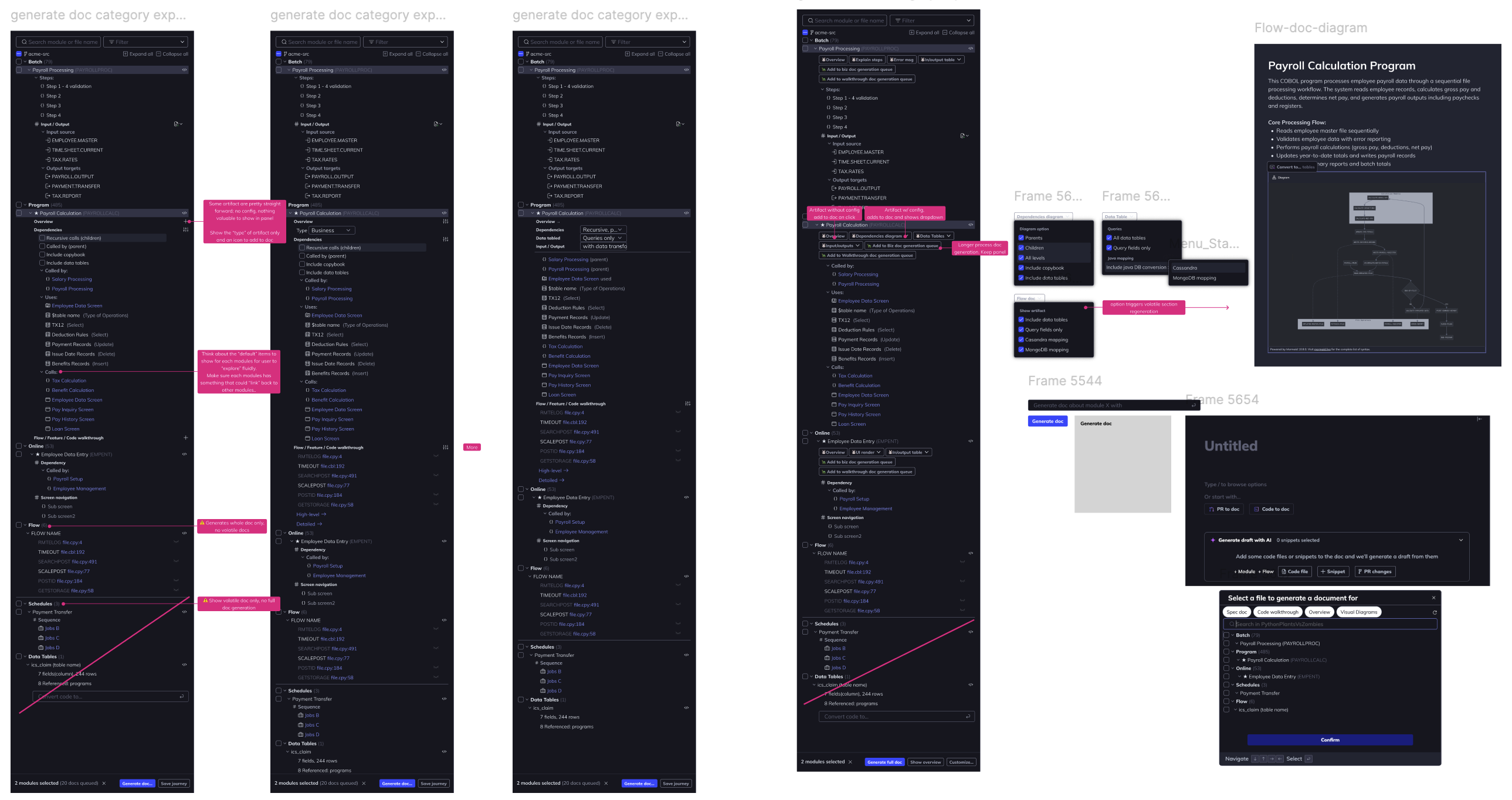Codebase Intelligence Discovery
This project helps developers understand their legacy codebases with AI. The project focuses on discovering major components, interesting flows, classes, code dependencies, and call graphs in the codebases and curating them into comprehensive yet digestible series artifacts.
Role
UX Design
User testing
Team
1 engineers
2 AI researcher
Outcome
Contributed to $1.2M in ARR through 10 signed POCs, by addressing key modernization frictions in understanding codebase.
Reduce cognitive load and increase understanding for modernization teams
⬇ Ready to see how it all came together? Let’s dive in. ⬇
Context
Swimm used to be a developer tool focused on documentation. We pivoted to support legacy codebases.
Problem
Our original solution focused on bulk doc generation, producing large sets of structured documents for components and flows doesn't help modernization teams enough.
Through user interviews, usability tests, and previous sales conversations, we learned:
- Overwhelming noise kills trust: Users felt lost in long content. They constantly felt the need to "review" the docs due to the nature of outcome, rather than finding what they need for their current modernization focus.
- Missing flexibility: All modules under a certain category are output with the same structure.
- Use case oriented: Modernization usually starts with a goal in mind (i.e. compliance, report, performance, etc), each is directed to a different business process and anchor points in the code.
We realized that AutoDocs shouldn’t just generate documents. It should help developers navigate and understand legacy systems step by step.
How might we turn “AutoDocs”
into a modernization partner, helping developers discover and understand their legacy codebase progressively?
Solution:
Base on the above information, we are aligned that:
- Value must appear first: Present are most confident findings base on our analysis.
- Customization is important: Users wanted control over the topics they see, not a one-size-fits-all export. The over rigid grouping also makes the hierarchy irrelevant for them.
- Show progressive layer: Business process first, code comes next
High-level changes
Discovery insights
As we dive deeper from the "How-might-we" statement above, we can break it into more smaller pieces.
What are the immediate value we can provide them base on their modernization goal?
How do we show those insights?
What other customization would they want?
Given these questions, we mapped the artifacts that we can do base on our AI analysis and LLM supported output. It gave us a good idea of what and how to present the artifact.
Analysis-based artifact
Hierarchy structure, call graphs, IO for batch jobs, glossary candidates.LLM outputs (slower). Instant generation from previous analysis
LLM-based artifact
Summaries, business rule extraction, flow narratives. Needs time to generate.
Entity to Artifact mapping (intentionally blurred for NDA purpose)
- Call graphs: Tech implementation, important to know interdependencies of modules and components.
- Business process & rules: Governs how the business operates, most interested for business people
- Interface flow & fields: Snapshot of screens user interacts with, along with the datas needed
- Data presentation: Dictionary or definition of the entire business and where they're being used
Mapping the dependency, hierarchy, and artifact
As part of research, we look at how other competitors like IBM Watsons or Core Migration are showing dependency. These dependency can be a call graph of an end-to-end business process. Which contains multiple programs, screens, data points, calculations.
Research on call graph representation
I explored to whether put the different type of artifact separately. Since the LLM based generation is non-deterministic and takes longer time to generate Ex. placing the immediate value on the same panel we're showing the hierarchy.
Exploration on Analysis-based and LLM-based artifact
Updated user flow
We end up scrapping the idea, and decide to make all artifact appear to the right panel. Making the left side focus solely on the hierarchy.
v1 Customization & Previews
- Provides flexible artifact customization with preview of mini sections
- Artifacts on each level are customizable and changes instantly
v2 Business Process
- Included business process on the left-panel, supported by aliases.
- Once queried, takes you to individual item, whether that's a business focus or tech oriented.
- The tabs shows all the different artifacts generated.
- Minimized the LLM generation to only showing up as a small description.










